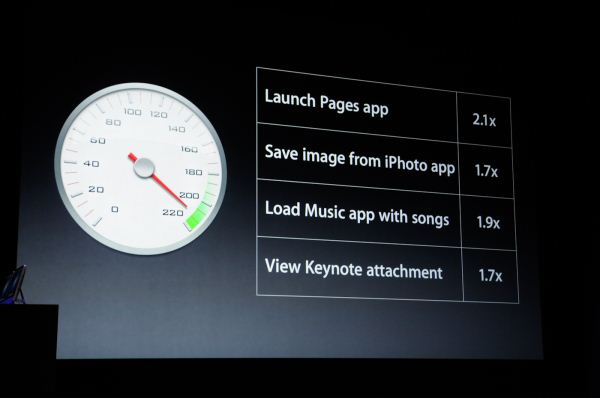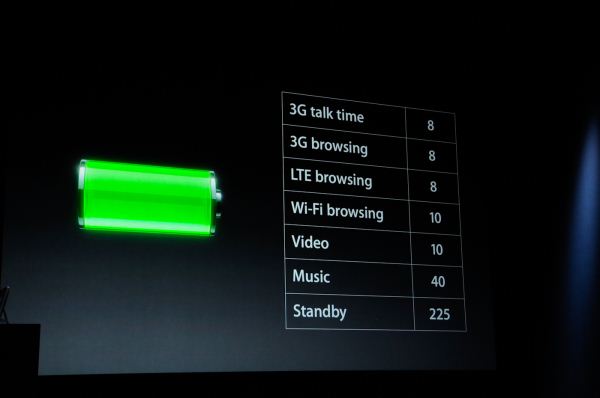The iPhone 5's A6 SoC: Not A15 or A9, a Custom Apple Core Instead
by Anand Lal Shimpi on September 15, 2012 2:15 PM EST- Posted in
- Smartphones
- Apple
- Mobile
- SoCs
- iPhone 5
When Apple announced the iPhone 5, Phil Schiller officially announced what had leaked several days earlier: the phone is powered by Apple's new A6 SoC.
As always, Apple didn't announce clock speeds, CPU microarchitecture, memory bandwidth or GPU details. It did however give us an indication of expected CPU performance:
Prior to the announcement we speculated the iPhone 5's SoC would simply be a higher clocked version of the 32nm A5r2 used in the iPad 2,4. After all, Apple seems to like saving major architecture shifts for the iPad.
However, just prior to the announcement I received some information pointing to a move away from the ARM Cortex A9 used in the A5. Given Apple's reliance on fully licensed ARM cores in the past, the expected performance gains and unpublishable information that started all of this I concluded Apple's A6 SoC likely featured two ARM Cortex A15 cores.
It turns out I was wrong. But pleasantly surprised.
The A6 is the first Apple SoC to use its own ARMv7 based processor design. The CPU core(s) aren't based on a vanilla A9 or A15 design from ARM IP, but instead are something of Apple's own creation.
Hints in Xcode 4.5
The iPhone 5 will ship with and only run iOS 6.0. To coincide with the launch of iOS 6.0, Apple has seeded developers with a newer version of its development tools. Xcode 4.5 makes two major changes: it drops support for the ARMv6 ISA (used by the ARM11 core in the iPhone 2G and iPhone 3G), keeps support for ARMv7 (used by modern ARM cores) and it adds support for a new architecture target designed to support the new A6 SoC: armv7s.
What's the main difference between the armv7 and armv7s architecture targets for the LLVM C compiler? The presence of VFPv4 support. The armv7s target supports it, the v7 target doesn't. Why does this matter?
Only the Cortex A5, A7 and A15 support the VFPv4 extensions to the ARMv7-A ISA. The Cortex A8 and A9 top out at VFPv3. If you want to get really specific, the Cortex A5 and A7 implement a 16 register VFPv4 FPU, while the A15 features a 32 register implementation. The point is, if your architecture supports VFPv4 then it isn't a Cortex A8 or A9.
It's pretty easy to dismiss the A5 and A7 as neither of those architectures is significantly faster than the Cortex A9 used in Apple's A5. The obvious conclusion then is Apple implemented a pair of A15s in its A6 SoC.
For unpublishable reasons, I knew the A6 SoC wasn't based on ARM's Cortex A9, but I immediately assumed that the only other option was the Cortex A15. I foolishly cast aside the other major possibility: an Apple developed ARMv7 processor core.
Balancing Battery Life and Performance
There are two types of ARM licensees: those who license a specific processor core (e.g. Cortex A8, A9, A15), and those who license an ARM instruction set architecture for custom implementation (e.g. ARMv7 ISA). For a long time it's been known that Apple has both types of licenses. Qualcomm is in a similar situation; it licenses individual ARM cores for use in some SoCs (e.g. the MSM8x25/Snapdragon S4 Play uses ARM Cortex A5s) as well as licenses the ARM instruction set for use by its own processors (e.g. Scorpion/Krait implement in the ARMv7 ISA).
For a while now I'd heard that Apple was working on its own ARM based CPU core, but last I heard Apple was having issues making it work. I assumed that it was too early for Apple's own design to be ready. It turns out that it's not. Based on a lot of digging over the past couple of days, and conversations with the right people, I've confirmed that Apple's A6 SoC is based on Apple's own ARM based CPU core and not the Cortex A15.
Implementing VFPv4 tells us that this isn't simply another Cortex A9 design targeted at higher clocks. If I had to guess, I would assume Apple did something similar to Qualcomm this generation: go wider without going substantially deeper. Remember Qualcomm moved from a dual-issue mostly in-order architecture to a three-wide out-of-order machine with Krait. ARM went from two-wide OoO to three-wide OoO but in the process also heavily pursued clock speed by dramatically increasing the depth of the machine.
The deeper machine plus much wider front end and execution engines drives both power and performance up. Rumor has it that the original design goal for ARM's Cortex A15 was servers, and it's only through big.LITTLE (or other clever techniques) that the A15 would be suitable for smartphones. Given Apple's intense focus on power consumption, skipping the A15 would make sense but performance still had to improve.
Why not just run the Cortex A9 cores from Apple's A5 at higher frequencies? It's tempting, after all that's what many others have done in the space, but sub-optimal from a design perspective. As we learned during the Pentium 4 days, simply relying on frequency scaling to deliver generational performance improvements results in reduced power efficiency over the long run.
To push frequency you have to push voltage, which has an exponential impact on power consumption. Running your cores as close as possible to their minimum voltage is ideal for battery life. The right approach to scaling CPU performance is a combination of increasing architectural efficiency (instructions executed per clock goes up), multithreading and conservative frequency scaling. Remember that in 2005 Intel hit 3.73GHz with the Pentium Extreme Edition. Seven years later Intel's fastest client CPU only runs at 3.5GHz (3.9GHz with turbo) but has four times the cores and up to 3x the single threaded performance. Architecture, not just frequency, must improve over time.
At its keynote, Apple promised longer battery life and 2x better CPU performance. It's clear that the A6 moved to 32nm but it's impossible to extract 2x better performance from the same CPU architecture while improving battery life over only a single process node shrink.
Despite all of this, had it not been for some external confirmation, I would've probably settled on a pair of higher clocked A9s as the likely option for the A6. In fact, higher clocked A9s was what we originally claimed would be in the iPhone 5 in our NFC post.
I should probably give Apple's CPU team more credit in the future.
The bad news is I have no details on the design of Apple's custom core. Despite Apple's willingness to spend on die area, I believe an A15/Krait class CPU core is a likely target. Slightly wider front end, more execution resources, more flexible OoO execution engine, deeper buffers, bigger windows, etc... Support for VFPv4 guarantees a bigger core size than the Cortex A9, it only makes sense that Apple would push the envelope everywhere else as well. I'm particularly interested in frequency targets and whether there's any clever dynamic clock work happening. Someone needs to run Geekbench on an iPhone 5 pronto.
I also have no indication how many cores there are. I am assuming two but Apple was careful not to report core count (as it has in the past). We'll get more details as we get our hands on devices in a week. I'm really interested to see what happens once Chipworks and UBM go to town on the A6.













163 Comments
View All Comments
cocoviper - Sunday, September 16, 2012 - link
I think you're forgetting there's a larger display and additional radio to drive. The fact that they held the line on power performance with those added and no real battery increase suggests tremendous power savings at the SoC level.lilmoe - Sunday, September 16, 2012 - link
They also have a larger battery to compensate for that larger screen and the new radios. I'd say this new SoC has the same power consumption as the previous A5 at best...Lucian Armasu - Sunday, September 16, 2012 - link
The battery life with LTE will be influeced only by how efficient the chip is. If they are using a 28nm radio, it should be pretty efficient, but probably not more than other companies.Death666Angel - Sunday, September 16, 2012 - link
As I understand it, smart software can also enhance LTE battery life. But mostly it's the chip and process node.Lepton87 - Saturday, September 15, 2012 - link
Was I the only one to notice that 2x the performance of A9 at 800MHz is actually pathetic? Anand always seems to drool over anything apple related, numbers be damned. Krait at 1.5GHz is going to mop the floor with that thing. Even Tegra 3 T33 will have comparable ST CPU performance with that thing. (A9 at 1.7GHz) This is already 2x faster than iPhone 4s CPU. Those numbers are actually PATHETIC and yet anand drools over that.darkcrayon - Saturday, September 15, 2012 - link
Well, if Apple's general claims are correct, that it has 2x the CPU and 2x the GPU of the iPhone 4S, the performance should be quite good. Remember, Apple didn't say twice the performance of "an A9". We're talking about the actual device here. The iPhone 4S is competitive with phones on the market with twice the clock speed at CPU tasks, and is faster than almost everything in GPU tasks.This new iPhone is clearly going to be no slouch in the performance department, regardless of your lack of interest because Apple produced it.
EnzoFX - Saturday, September 15, 2012 - link
Seriously. Biased much? So many here are getting lost in numbers. It remains to be seen if the hardware, combined with better optimized software (the #1 thing Apple has over any android offering) will mean pages are actually rendered faster, etc.In regards to graphics, I don't even really look at them these days. It seems Apple is simply uncontested in the graphics department. This can be bad, they need the competition to become more aggressive. Though this update I'm sure will be an iterative one, and will still be great, and still uncontested!
ltcommanderdata - Saturday, September 15, 2012 - link
Despite your complaints, I don't remember reading Anand claiming the A6 has superior performance to other current or upcoming high-end SoC. Instead the focus is on how to increase performance in the most power efficient way. While Apple has traditionally focused on having leading GPU performance in their SoC, they haven't done the same for the CPU. As such, it wouldn't be surprising if the A6 is merely competitive, but is not the fastest CPU. If the reason Apple moved to a custom design is to increase power efficiency, the question of how successful they were needs to be answered by comparing performance/watt between SoC designs rather than raw maximum performance. I'm not sure there are very good ways to benchmark performance/watt between various mobile devices though.cocoviper - Sunday, September 16, 2012 - link
Actually if you look at past benchmarks Apple's dual A9s at 800MHz pretty much tie with Tegra3 (due to more efficient software).http://images.anandtech.com/graphs/graph6098/49612...
2x that performance puts it squarely in the realm of Krait or slightly better.
lilmoe - Sunday, September 16, 2012 - link
Try again with Jelly Bean and a faster browser. Really, those Sunspider benchmarks don't show the whole picture when a webpage is loading and being rendered on the screen...But if you want to see a more valid comparison, I'd suggest you wait for IE10 on Windows Phone 8 (highly optimized for the Snapdragon S4, unlike Android) and compare the browser speeds and general OS performance on that with the iPhone 5... You'll have a better picture.